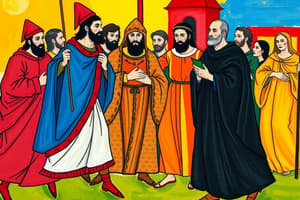Podcast
Questions and Answers
What was the approximate duration of the Medieval Period?
What was the approximate duration of the Medieval Period?
- 300-1000 CE
- 1000-1800 CE
- 500-1500 CE (correct)
- 1500-2000 CE
What marked the end of classical antiquity and the beginning of the Middle Ages?
What marked the end of classical antiquity and the beginning of the Middle Ages?
- Fall of the Roman Empire (correct)
- Crusades
- Viking Invasions
- Rise of Christianity
What was the dominant religion in Europe during the Medieval Period?
What was the dominant religion in Europe during the Medieval Period?
- Christianity (correct)
- Islam
- Judaism
- Paganism
What was the outcome of the Black Death pandemic?
What was the outcome of the Black Death pandemic?
What was the purpose of the Crusades?
What was the purpose of the Crusades?
What was the characteristic of the feudal system?
What was the characteristic of the feudal system?
What is an example of medieval literary achievement?
What is an example of medieval literary achievement?
Who is credited with unifying much of Western Europe and promoting education and the arts?
Who is credited with unifying much of Western Europe and promoting education and the arts?
Flashcards are hidden until you start studying
Study Notes
Medieval Period (approx. 500-1500 CE)
Overview
- Also known as the Middle Ages, this period marked the transition from the fall of the Roman Empire to the Renaissance.
- Characterized by feudalism, the rise of Christianity, and the struggle for power among royal families and nobility.
Key Events
- Fall of the Roman Empire (476 CE): Marked the end of classical antiquity and the beginning of the Middle Ages.
- Rise of Christianity: Became the dominant religion in Europe, with the Catholic Church playing a central role in politics and society.
- Viking Invasions (8th-11th centuries): Scandinavians raided and settled in various parts of Europe, leaving a lasting impact on language, culture, and politics.
- Crusades (1095-1291): A series of military campaigns launched by European Christians to reclaim the Holy Land from Muslim rule.
- Black Death (1346-1353): A pandemic that devastated Europe, leading to significant social, economic, and cultural changes.
Social Structure
- Feudalism: A hierarchical system in which lords granted land to vassals in exchange for loyalty and military service.
- Nobility: Royalty and nobles held power and wealth, while peasants and serfs worked the land.
- Guilds: Associations of craftsmen and merchants that regulated trade and commerce.
Cultural Achievements
- Architecture: Gothic cathedrals, castles, and monasteries showcased medieval engineering and artistic skills.
- Literature: Works like The Canterbury Tales ( Geoffrey Chaucer) and The Song of Roland (anonymous) reflected the period's cultural and literary developments.
- Art and Music: Illuminated manuscripts, stained glass, and Gregorian chant exemplified medieval artistic expression.
Notable Figures
- Charlemagne (741-814): King of the Franks, united much of Western Europe, and promoted education and the arts.
- Thomas Aquinas (1225-1274): Dominican friar and philosopher who synthesized Aristotelian philosophy with Christian theology.
- Joan of Arc (1412-1431): French heroine who led the resistance against English occupation during the Hundred Years' War.
Medieval Period (approx. 500-1500 CE)
Overview
- Lasted from the fall of the Roman Empire to the Renaissance
- Characterized by feudalism, rise of Christianity, and power struggles among royal families and nobility
Key Events
- Fall of the Roman Empire (476 CE): marked the end of classical antiquity and the beginning of the Middle Ages
- Rise of Christianity: became the dominant religion in Europe, with the Catholic Church playing a central role in politics and society
- Viking Invasions (8th-11th centuries): Scandinavians raided and settled in various parts of Europe, leaving a lasting impact on language, culture, and politics
- Crusades (1095-1291): military campaigns launched by European Christians to reclaim the Holy Land from Muslim rule
- Black Death (1346-1353): pandemic that devastated Europe, leading to significant social, economic, and cultural changes
Social Structure
- Feudalism: hierarchical system in which lords granted land to vassals in exchange for loyalty and military service
- Nobility: royalty and nobles held power and wealth, while peasants and serfs worked the land
- Guilds: associations of craftsmen and merchants that regulated trade and commerce
Cultural Achievements
- Architecture: Gothic cathedrals, castles, and monasteries showcased medieval engineering and artistic skills
- Literature: works like The Canterbury Tales (Geoffrey Chaucer) and The Song of Roland (anonymous) reflected the period's cultural and literary developments
- Art and Music: illuminated manuscripts, stained glass, and Gregorian chant exemplified medieval artistic expression
Notable Figures
- Charlemagne (741-814): King of the Franks, united much of Western Europe, and promoted education and the arts
- Thomas Aquinas (1225-1274): Dominican friar and philosopher who synthesized Aristotelian philosophy with Christian theology
- Joan of Arc (1412-1431): French heroine who led the resistance against English occupation during the Hundred Years' War
Studying That Suits You
Use AI to generate personalized quizzes and flashcards to suit your learning preferences.




